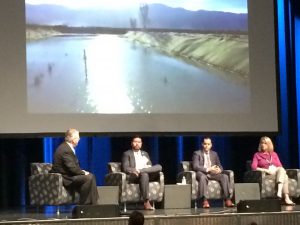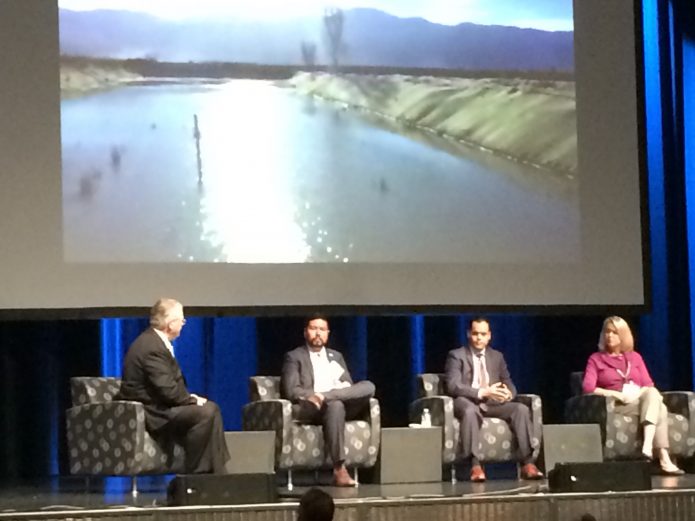
Panelists at the Desert Sun’s water and energy summit held Jan. 11 in Palm Springs discuss the future of the Salton Sea under the State’s Salton Sea Management Program. Pictured (from left to right) are Phil Rosentrater, executive director of the Salton Sea Authority, E. Joaquin Esquivel of the State Water Resources Control Board, Antonio Ortega of Imperial Irrigation District and Kim Delfino with Defenders of Wildlife. Bruce Wilcox, California Natural Resources Assistant Secretary in charge of Salton Sea Policy, also took part on the panel.
On Thursday, Jan. 11., representatives from parties engaged in the Salton Sea struck an optimistic tone regarding the Sea’s future during a water and energy summit sponsored by the Desert Sun newspaper, held in Palm Springs. The Salton Sea has continuously been a key focus of the annual summit, but this year was different—more positive—and there are reasons for that, which all point to a more unified vision for the Sea.
Panelists during an hour-long discussion included Bruce Wilcox, Assistant Secretary for California Natural Resources in charge of Salton Sea Policy, E. Joaquin Esquivel, member of the California Water Resources Control Board, Antonio Ortega, government affairs for the Imperial Irrigation District, Kim Delfino of the Defenders of Wildlife, and Jennifer Toy of Kounkey Design Initiative, an organization developing an environmental justice outreach program for the communities around the Sea’s northern shore. Phil Rosentrater, executive director of the Salton Sea Authority, served as the moderator.
What perhaps made this year’s discussion different from past summit panels, in this writer’s opinion, is that past discussions have focused on the impending end of mitigation water to the Sea and concern about what that might mean coupled with a lack of movement on the part of the State to implement a restoration program. So, past discussions took a decidedly gloom-and-doom focus on the future of the Sea. This year the tone was hopeful based on what has occurred over the past year and, in particular, the last quarter of 2017.
The discussion by panelists still addressed the fact that, as of the start of this year, mitigation water to the Sea has ended (though there still will remain as much as 750,000 acre-feet of inflows to the Sea annually—quite a bit of water to maintain a smaller but sustainable lake). However, panelists highlighted that for the first time in quite a while the parties have unified around a plan for the Salton Sea. That plan is the State’s Salton Sea Management Program (SSMP). In its initial 10-year Phase One implementation, the SSMP is to cover some 30,000 acres of exposed playa with a mix of habitat and air quality projects.
One key factor, according to panelists, that will reinforce the SSMP is the stipulated water order drafted by the Imperial Irrigation District, Imperial County and the San Diego County Water Authority with the support from the State and environmental organizations, which established annual milestones for the SSMP and a timeline to develop a long-range plan for the Sea. The stipulated order also established that the State Water Resources Control Board (SWRCB) would have continuing jurisdiction over the restoration effort independent from the State Water Board’s jurisdiction over the mitigation efforts at the Sea under the Quantification Settlement Agreement (QSA). The SWRCB in November adopted the stipulated order as an amendment to the water order that originally approved the QSA. This was a critical step in ensuring the State would be held responsible for meeting annual goals for its restoration program. It is also critical because if such goals are not met, the State will have to come forward with alternatives to ensure the missed goals will be addressed.
While the panelists were optimistic, they also voiced caution that the work has only just begun and the proof that momentum has turned will come with time. Such caution is warranted. And it is understandable if those who live closest to the Sea are wary of what is to come, as for years the State has been sluggish in moving forward with any kind of restoration program. Adding to the concern is the need for additional State and Federal funding for the Sea. However, as the panelists suggested, there is every reason to be hopeful as we move into a new year and look toward a new future for the Salton Sea. A water bond to be voted on in June 2018 could bring $200 million to the Salton Sea restoration effort and restoration projects will be moving forward this year. Additionally, mitigation projects will be moving ahead to address the QSA’s potential impacts on the Sea. Stay posted to this blog for continuing updates on the Salton Sea as they occur and if you have questions, contact this writer at dsimon@sdcwa.org or at 760.337.1386.
